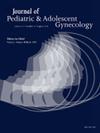51. 高血管化卵巢实体瘤,好惊喜:卵巢硬化间质瘤
IF 1.7
4区 医学
Q3 OBSTETRICS & GYNECOLOGY
引用次数: 0
摘要
背景:硬化性间质瘤(SST)是一种罕见的卵巢良性性索间质瘤(SCST),占卵巢SCST病例的不到5%。我们的目的是提出一个病例,实性卵巢肿瘤,最初怀疑恶性由于影像学结果,最终被诊断为良性SST在月经初露后的青少年。病例1:14岁女孩,髓母细胞瘤病史,因严重身材矮小,接受内分泌护理,化疗和放疗。盆腔超声示左侧卵巢实性均匀血管增生肿瘤(18cc),无囊性区或钙化。CT证实左侧附件有一个清晰的高显影肿块(27 × 49 × 32 mm),移位了附近的结构。肿瘤标志物:LDH 285 U/L、BhCG <;2.4 mIU/mL, Alpha Feto蛋白<;2 ng/mL,抗苗勒管激素0.77 ng/mL, Ca 125 32.8 U/mL, Ca 19-9 20.7 U/mL, CEA 2.7 ng/mL。行腹腔镜左附件切除术,组织病理学证实卵巢SST。患者恢复良好,未发现恶性肿瘤。本病例经医院伦理委员会路易斯·卡尔沃·麦肯纳医生审查并批准。尽管SST的发病率很低,尤其是在年轻女孩中,但其临床和影像学表现可能与恶性肿瘤相似。本病例强调了影像学和组织病理学诊断的重要性。MRI可以帮助识别良性特征,避免过度治疗,保留生育能力。肿瘤是良性的,这让病人和她的家人感到放心。财务披露:作者没有与本案例相关的财务关系需要披露。本文章由计算机程序翻译,如有差异,请以英文原文为准。
51. Hypervascularized solid ovarian tumor, what a good surprise: ovarian sclerosing stromal tumor
Background
Sclerosing stromal tumor (SST) is a rare benign sex cord-stromal tumor (SCST) of the ovary, accounting for less than 5% of all ovarian SCST cases. We aim to present a case where a solid ovarian tumor, initially suspected as malignant due to imaging findings, was ultimately diagnosed as a benign SST in a postmenarcheal adolescent.
Case
A 14-year-old girl with a history of medulloblastoma, treated with chemotherapy and radiotherapy, was under endocrine care for severe short stature. A pelvic ultrasound revealed a solid, homogeneous, hypervascularized tumor in the left ovary (18 cc), without cystic areas or calcifications. CT confirmed a well-defined, hyperenhancing mass (27 × 49 × 32 mm) in the left adnexa, displacing nearby structures. Tumor markers were negative: LDH 285 U/L, BhCG < 2.4 mIU/mL, Alpha Feto protein < 2 ng/mL, Anti-Mullerian hormone 0.77 ng/mL, Ca 125 32.8 U/mL, Ca 19-9 20.7 U/mL, CEA 2.7 ng/mL. Laparoscopic left adnexectomy was performed, and histopathology confirmed an ovarian SST. The patient's recovery was favorable, and no malignancy was detected. This case was reviewed and approved by the Ethics Committee of Hospital Dr. Luis Calvo Mackenna.
Comments
Despite the low incidence of SST, particularly in young girls, its clinical and imaging findings can mimic malignancy. This case underscores the importance of imaging and histopathology for diagnosis. MRI may help identify benign features and avoid overtreatment, preserving fertility. The benign nature of the tumor provided reassurance to the patient and her family. Financial Disclosure: The authors have no financial relationships relevant to this case to disclose.
求助全文
通过发布文献求助,成功后即可免费获取论文全文。
去求助
来源期刊
CiteScore
3.90
自引率
11.10%
发文量
251
审稿时长
57 days
期刊介绍:
Journal of Pediatric and Adolescent Gynecology includes all aspects of clinical and basic science research in pediatric and adolescent gynecology. The Journal draws on expertise from a variety of disciplines including pediatrics, obstetrics and gynecology, reproduction and gynecology, reproductive and pediatric endocrinology, genetics, and molecular biology.
The Journal of Pediatric and Adolescent Gynecology features original studies, review articles, book and literature reviews, letters to the editor, and communications in brief. It is an essential resource for the libraries of OB/GYN specialists, as well as pediatricians and primary care physicians.

 求助内容:
求助内容: 应助结果提醒方式:
应助结果提醒方式:


